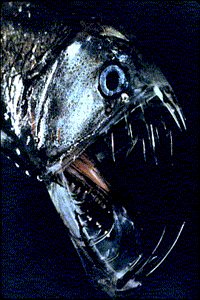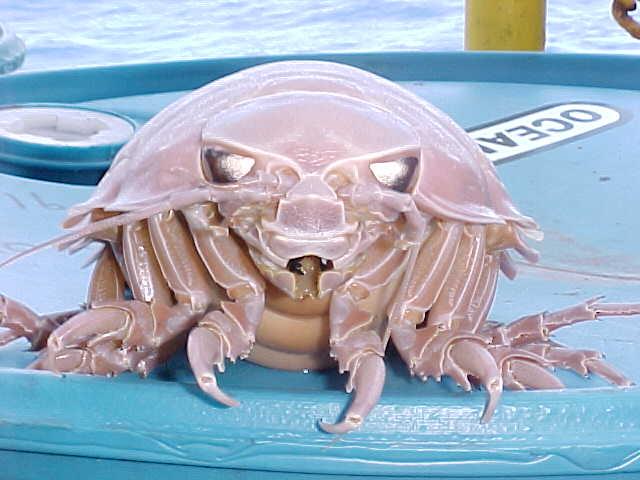Dog--
The Freeman
- Joined
- Apr 16, 2005
- Messages
- 9,741
- Reaction score
- 25
First off, I want to say that I LOVE ocean life, it's just the most fascinating. It's probably because it's so odd and out of the ordinary that I find it really cool, I mean you never find things as big a sperm whales, or as beautiful/odd as starfish on land, but in the ocean.. It's just fantastic. I want to show you some animals I think are really cool that come from the deep depths of the ocean...

Predatory-Tunicate (Megalodicopia hians)
Physical Characteristics: Predatory tunicates live anchored along the deep sea canyon walls and seafloor, waiting for tiny animals to drift or swim into their cavernous hoods. These are normally up to to 5 inches across (13 cm).
If you've ever seen a Venus fly trap capture an insect, you have a clue as to how a predatory tunicate eats. Its mouthlike hood is quick to close when a small animal drifts inside. Once the tunicate catches a meal, it keeps its trap shut until it's ready to eat again.
Distribution: Mostly these are distributed in Monterey Canyon at depths of 600-3,300 feet (183-1,000 meters).
Food: These are mostly eating zooplankton and tiny animals.

Pacific Blackdragon (Idiacanthus antrostomus)
Physical Characteristics: Female blackdragons are about two feet (61 cm) long and have fang-like teeth and a long chin whisker. The males are small, about three inches (8 cm) in length, and brownish in color. They have no teeth, no chin barbel and no stomach. Unable to eat, the male lives only long enough to mate. They females are normally up to 24 inches (61 cm) while males up to 3 inches (8 cm).
Distribution: Mostly these are distributed on rocky surfaces at depths of 700-4,050 feet or 213-1,243 meters.
Food: They are mostly eating crustaceans, shrimp, fishes.

Hula Skirt Siphonophore (Physophora hydrostatica)
Physical Characteristics: This siphonophore has a float and swimming bells. It's able to regulate its density by changing the amount of gas in its float. The float has a pore at the bottom that emits gas and can be refilled with secretions produced by a special gland. They are normally up to 16 inches or 941 cm long in size.
Distribution: Mostly these are distributed in mid-water of depth 2,297-3,281 feet, or 700-1,000 meters.
Food: They are mostly eating animal plankton.

Johnson's Sea Cucumber (Parastichopus johnsoni)
Physical Characteristics: Sea cucumbers are soft-bodied and live at all ocean depths, from the shallows to the abyss. These are normally up to to 16 inches long (40 cm).
Most sea cucumbers move slowly by using their tiny tube feet, but some also have a faster escape response��they swim by flexing their bodies and inching along the seafloor.
As a deep sea cucumber crawls across the seafloor, mud and tiny pieces of fallen food cling to its sticky tentacles. The cucumber stuffs those coated tentacles into its mouth and cleans them off��devouring the muddy mixture and digesting the edible scraps.
Distribution: Mostly these are distributed at the seafloor, 100-1,300 feet (30-400 m).
Food: These are mostly eating plant and animal scraps, small organisms.

Pom-Pom Anemone (Liponema brevicornis)
Physical Characteristics: A pom-pom anemone takes on a variety of shapes�from low and flat to round and puffy. In fact, scientists have seen puffed up anemones rolling across the seafloor like living tumbleweeds, �blown� by deep sea currents. They are up to 10 inches or 25 cm in size.
Scientists aren't sure why pom-pom anemones change shape and roll around, they might be looking for 'greener pastures', where there's more food to eat.
Distribution: Mostly these are distributed in soft, muddy seafloor at depths of 330-3,300 feet or 100-1,000 meters.
Food: They are mostly eating plankton and other drifting food.

Bloodybelly Comb Jelly (Lampocteis sp.)
Physical Characteristics: The body color of the bloodybelly comb jelly ranges from pale to deep purple, to deep red and sometimes black. Like other comb jellies, it propels itself by moving paddle-like organs, called combs, which are composed of hundreds of cilia. These are having size up to 4.5 inches (12 cm).
The bloodybelly is a fragile comb jelly that wasn't discovered until scientists were able to use submersibles to make direct observations of deep sea animals.
Distribution: Mostly these are distributed in midwater (2,297-3,281 feet, or 700-1,000 meters).

Giant Siphonophore (Praya sp.)
Physical Characteristics: Giant siphonophores, like all siphonophores, are a collection of highly specialized working parts. Some parts catch prey, others digest food, some parts reproduce and others direct the action by swimming. This siphonophore is bioluminescent, it creates its own light. When it bumps against something, its stem glows with a bright blue light. They are normally 130 feet long (40 m), but body is only as thick as a broomstick.
Distribution: Mostly these are distributed in midwater of depth 2,297-3,281 feet, or 700-1,000 meters.
Food: They are mostly eating small crustaceans, other gelatinous animals, maybe fish larvae and small fishes.
Hopefully you enjoy these (I know there are some people here who hate this stuff), and we can have discussions of some sort on these wierd creatures.
All this info came from here: http://www.allthesea.com/

Predatory-Tunicate (Megalodicopia hians)
Physical Characteristics: Predatory tunicates live anchored along the deep sea canyon walls and seafloor, waiting for tiny animals to drift or swim into their cavernous hoods. These are normally up to to 5 inches across (13 cm).
If you've ever seen a Venus fly trap capture an insect, you have a clue as to how a predatory tunicate eats. Its mouthlike hood is quick to close when a small animal drifts inside. Once the tunicate catches a meal, it keeps its trap shut until it's ready to eat again.
Distribution: Mostly these are distributed in Monterey Canyon at depths of 600-3,300 feet (183-1,000 meters).
Food: These are mostly eating zooplankton and tiny animals.

Pacific Blackdragon (Idiacanthus antrostomus)
Physical Characteristics: Female blackdragons are about two feet (61 cm) long and have fang-like teeth and a long chin whisker. The males are small, about three inches (8 cm) in length, and brownish in color. They have no teeth, no chin barbel and no stomach. Unable to eat, the male lives only long enough to mate. They females are normally up to 24 inches (61 cm) while males up to 3 inches (8 cm).
Distribution: Mostly these are distributed on rocky surfaces at depths of 700-4,050 feet or 213-1,243 meters.
Food: They are mostly eating crustaceans, shrimp, fishes.

Hula Skirt Siphonophore (Physophora hydrostatica)
Physical Characteristics: This siphonophore has a float and swimming bells. It's able to regulate its density by changing the amount of gas in its float. The float has a pore at the bottom that emits gas and can be refilled with secretions produced by a special gland. They are normally up to 16 inches or 941 cm long in size.
Distribution: Mostly these are distributed in mid-water of depth 2,297-3,281 feet, or 700-1,000 meters.
Food: They are mostly eating animal plankton.

Johnson's Sea Cucumber (Parastichopus johnsoni)
Physical Characteristics: Sea cucumbers are soft-bodied and live at all ocean depths, from the shallows to the abyss. These are normally up to to 16 inches long (40 cm).
Most sea cucumbers move slowly by using their tiny tube feet, but some also have a faster escape response��they swim by flexing their bodies and inching along the seafloor.
As a deep sea cucumber crawls across the seafloor, mud and tiny pieces of fallen food cling to its sticky tentacles. The cucumber stuffs those coated tentacles into its mouth and cleans them off��devouring the muddy mixture and digesting the edible scraps.
Distribution: Mostly these are distributed at the seafloor, 100-1,300 feet (30-400 m).
Food: These are mostly eating plant and animal scraps, small organisms.

Pom-Pom Anemone (Liponema brevicornis)
Physical Characteristics: A pom-pom anemone takes on a variety of shapes�from low and flat to round and puffy. In fact, scientists have seen puffed up anemones rolling across the seafloor like living tumbleweeds, �blown� by deep sea currents. They are up to 10 inches or 25 cm in size.
Scientists aren't sure why pom-pom anemones change shape and roll around, they might be looking for 'greener pastures', where there's more food to eat.
Distribution: Mostly these are distributed in soft, muddy seafloor at depths of 330-3,300 feet or 100-1,000 meters.
Food: They are mostly eating plankton and other drifting food.

Bloodybelly Comb Jelly (Lampocteis sp.)
Physical Characteristics: The body color of the bloodybelly comb jelly ranges from pale to deep purple, to deep red and sometimes black. Like other comb jellies, it propels itself by moving paddle-like organs, called combs, which are composed of hundreds of cilia. These are having size up to 4.5 inches (12 cm).
The bloodybelly is a fragile comb jelly that wasn't discovered until scientists were able to use submersibles to make direct observations of deep sea animals.
Distribution: Mostly these are distributed in midwater (2,297-3,281 feet, or 700-1,000 meters).

Giant Siphonophore (Praya sp.)
Physical Characteristics: Giant siphonophores, like all siphonophores, are a collection of highly specialized working parts. Some parts catch prey, others digest food, some parts reproduce and others direct the action by swimming. This siphonophore is bioluminescent, it creates its own light. When it bumps against something, its stem glows with a bright blue light. They are normally 130 feet long (40 m), but body is only as thick as a broomstick.
Distribution: Mostly these are distributed in midwater of depth 2,297-3,281 feet, or 700-1,000 meters.
Food: They are mostly eating small crustaceans, other gelatinous animals, maybe fish larvae and small fishes.
Hopefully you enjoy these (I know there are some people here who hate this stuff), and we can have discussions of some sort on these wierd creatures.
All this info came from here: http://www.allthesea.com/













